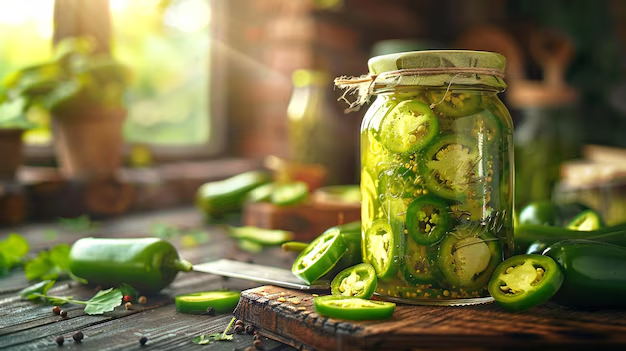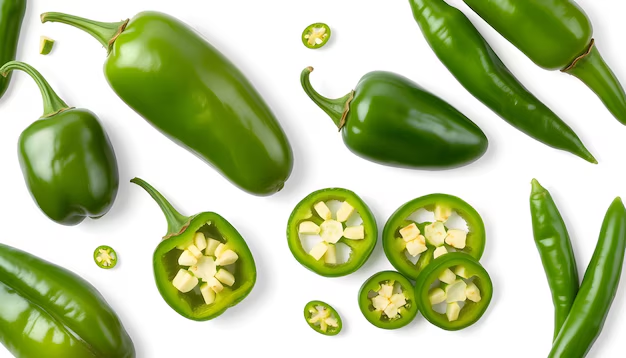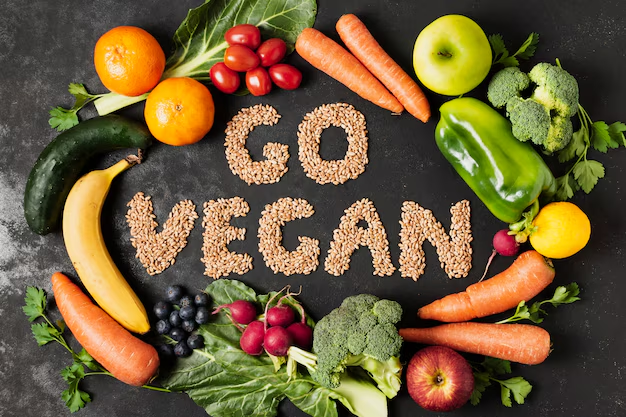Ever wondered how many canned jalapeños it takes to replicate the fiery kick of a fresh one? Or how many tablespoons of chopped jalapeños you need to spice up your dish? Are you looking for a milder alternative to these fiery peppers? And what’s the difference between fresh and pickled jalapeños? Dive in and discover the world of jalapeno conversions and substitutes, and unlock your culinary potential.
A single jalapeno pepper, including its seeds, typically weighs between 0.5 and 1 ounce (15 to 25 grams). This weight can vary slightly depending on factors such as size, ripeness, and growing conditions. When sliced, a cup of fresh or canned jalapenos generally maintains a similar weight.
So, whether you’re looking to add a kick to your tacos, create a smoky barbecue sauce, or simply experiment with different spice levels, this article has you covered.

Sliced Jalapeno Conversions
Sliced jalapenos are versatile and can be used in various dishes. Here’s a breakdown of their conversions:
Whole Jalapeno Equivalents:
| Whole Jalapenos | Cups | Ounces | Pounds | Gallons |
| 1 | 0.3 | 3 | 0.02 | 0.00007 |
| 2 | 0.6 | 6 | 0.04 | 0.00014 |
| 3 | 0.9 | 9 | 0.06 | 0.00021 |
| 4 | 1.2 | 12 | 0.08 | 0.00028 |
| 5 | 1.5 | 15 | 0.1 | 0.00035 |
Sliced Jalapeno Equivalents:
| Sliced Jalapenos | Cups | Ounces | Pounds | Gallons |
| 1 cup | 1 | 3 | 0.02 | 0.00007 |
| 2 cups | 2 | 6 | 0.04 | 0.00014 |
| 3 cups | 3 | 9 | 0.06 | 0.00021 |
| 4 cups | 4 | 12 | 0.08 | 0.00028 |
| 5 cups | 5 | 15 | 0.1 | 0.00035 |
Note: These conversions are based on the average weight of a whole jalapeno pepper (0.5-1 oz) and the assumption that sliced jalapenos are cut into uniform pieces. Actual weights may vary slightly.
Diced or Minced Jalapeno Conversions
Diced or minced jalapenos offer a more versatile form for adding heat to various dishes. Here’s a breakdown of their conversions:
Whole Jalapeno Equivalents:
| Whole Jalapenos | Tablespoons | Ounces | Pounds | Gallons |
| 1 | 1-2 | 0.5-1 | 0.03-0.06 | 0.00011-0.00022 |
| 2 | 2-4 | 1-2 | 0.06-0.12 | 0.00022-0.00044 |
| 3 | 3-6 | 1.5-3 | 0.09-0.18 | 0.00033-0.00066 |
| 4 | 4-8 | 2-4 | 0.12-0.25 | 0.00044-0.00088 |
| 5 | 5-10 | 2.5-5 | 0.16-0.31 | 0.00055-0.0011 |
Note: These conversions are based on the average weight of a whole jalapeno pepper (0.5-1 oz) and the assumption that diced or minced jalapenos are cut into small pieces. Actual weights may vary slightly.
Additional Considerations:
- Canned Jalapenos: The weight of canned jalapenos can be affected by the brine they’re packed in. For more accurate conversions, consider draining the brine before measuring.
- Fresh Jalapenos: The weight of fresh jalapenos can vary depending on factors such as size, ripeness, and the presence of stems and seeds.
- Substitutions: If you’re unable to find diced or minced jalapenos, consider using other chili peppers or hot sauce as substitutes.
Remember: These conversions are estimates, and actual weights may vary. It’s always recommended to taste and adjust the amount of jalapenos to your desired level of heat.
Need to know exactly how many jalapenos are in a pound, an ounce, or even larger quantities? Our comprehensive guide provides precise conversions and measurements, ensuring you have the perfect amount for your recipes.

Understanding Jalapeno Heat Levels and Adjusting Spiciness
Jalapenos are known for their fiery heat, but the exact spiciness can vary depending on several factors. Here’s a breakdown of jalapeno heat levels and tips for adjusting spiciness to your preference:
Heat Scale: Scoville Heat Units (SHU)
- Mild: 2,500-5,000 SHU
- Medium: 5,000-10,000 SHU
- Hot: 10,000-25,000 SHU
- Very Hot: 25,000-50,000 SHU
Note: These are general ranges, and individual jalapenos can vary within these levels.
Factors Affecting Heat:
- Ripeness: Ripe jalapenos tend to be milder than unripe ones.
- Growing Conditions: Factors like soil, climate, and growing practices can influence heat levels.
- Variety: Different jalapeno varieties can have varying degrees of spiciness.
Tips for Adjusting Spiciness:
- Remove Seeds and Membranes: The seeds and membranes contain most of the capsaicin, the compound responsible for heat. Removing them can significantly reduce the spiciness.
- Soak in Milk or Vinegar: Soaking jalapenos in milk or vinegar can help neutralize some of the heat.
- Combine with Milder Ingredients: Balance the heat of jalapenos by pairing them with milder ingredients like cream, cheese, or sweet fruits.
- Use a Smaller Amount: If you prefer a milder flavor, start with a smaller quantity of jalapenos and gradually increase as needed.
- Experiment with Different Cooking Methods: Cooking jalapenos can affect their heat. Roasting or grilling can mellow the heat, while boiling or simmering can intensify it.
By understanding jalapeno heat levels and using these tips, you can customize your dishes to your desired level of spiciness and enjoy the fiery flavor of jalapenos without overwhelming your palate.
Curious about the art of making jalapeno brine or juice? Our guide offers expert insights on the process, safety considerations, and delicious ways to use these flavorful creations in your cooking.

Storing and Preserving Jalapenos
Proper storage is essential to maintain the freshness and flavor of jalapenos. Here are some tips:
Storing Fresh Jalapenos:
- Refrigeration: Keep fresh jalapenos in the refrigerator in a sealed plastic bag or container. This will help prevent them from drying out or becoming moldy.
- Avoid Direct Sunlight: Exposure to direct sunlight can cause jalapenos to ripen quickly and lose their freshness.
- Wrap in Paper Towel: To absorb excess moisture and prevent spoilage, wrap jalapenos in a paper towel before storing.
Preserving Jalapenos:
- Pickling: Pickling is a popular method for preserving jalapenos. Submerge them in a brine solution containing vinegar, salt, and often sugar or spices.
- Freezing: To freeze jalapenos, slice them into desired shapes and place them in freezer bags or containers. For long-term storage, blanch them before freezing.
- Dehydrating: Dehydrating jalapenos is a great way to preserve their flavor and create a concentrated spice. Slice them thinly and dehydrate them in a food dehydrator or in a low-heat oven.
By following these storage and preservation techniques, you can enjoy the flavor of jalapenos year-round.
If you’re looking for some delicious recipes that use jalapenos, be sure to check out our extensive collection of jalapeno-inspired dishes. From spicy appetizers to hearty main courses, we have something for everyone. Whether you’re a seasoned cook or just starting out, you’re sure to find some new favorites.
Expert Tips for Working with Jalapenos
Here are some tips from culinary experts to help you master the art of working with jalapenos:
- Wear Gloves: Always wear gloves to protect your hands from the capsaicin, the compound that gives jalapenos their heat.
- Avoid Touching Your Face: After handling jalapenos, avoid touching your face, eyes, or other sensitive areas.
- Wash Your Hands Thoroughly: Wash your hands with soap and water after handling jalapenos to remove any residual capsaicin.
- Use a Cutting Board and Knife: To prevent cross-contamination, use a separate cutting board and knife for jalapenos.
- Consider Using Jalapeno Powder or Flakes: For a convenient way to add heat without the hassle of chopping fresh jalapenos, try using jalapeno powder or flakes.
By following these expert tips, you can confidently incorporate jalapenos into your cooking and create delicious, flavorful dishes.
Have you ever wondered if it’s safe to eat jalapeno seeds? Our guide provides expert answers and information on the potential effects, helping you make informed decisions about your culinary adventures.
By following the information and tips provided in this guide, you can confidently work with jalapenos and create delicious, flavorful meals that cater to your spice preferences. From precise measurements to expert advice, this resource has everything you need to master the art of using jalapenos in your top cuisines or recipes.






